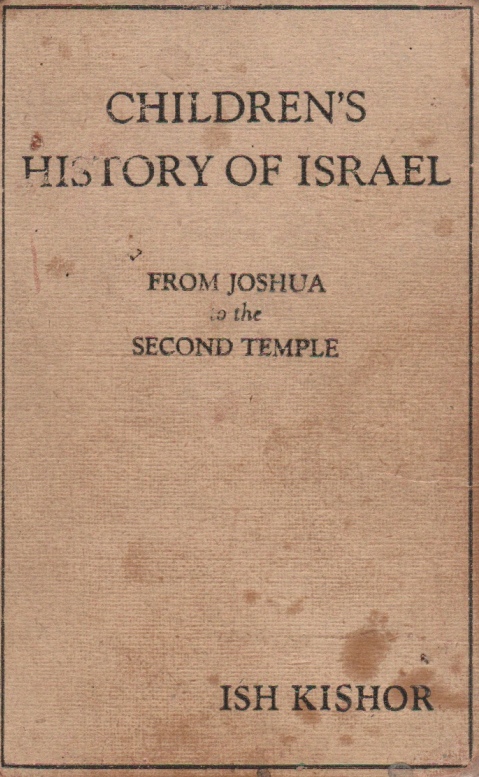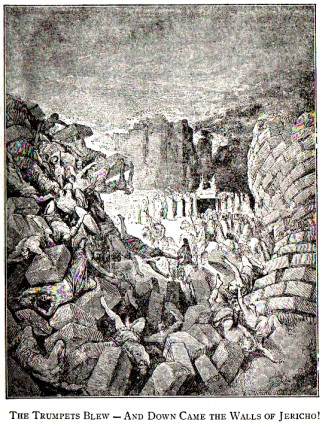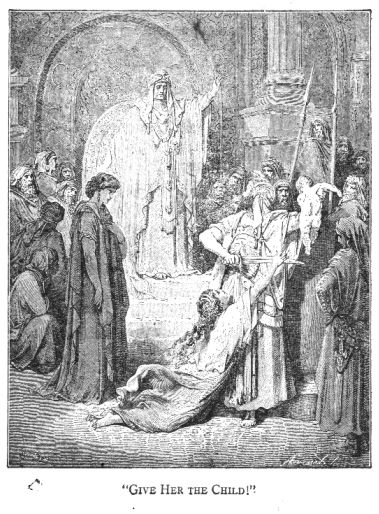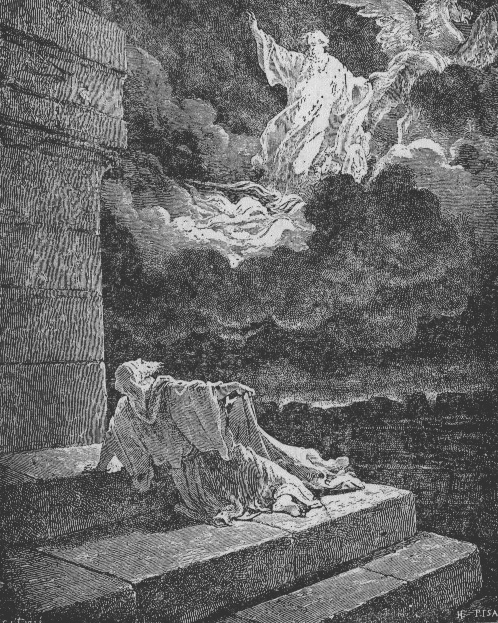By Don Jolly
I read Sulamith Ish-Kishor’s Children’s History of Israel: From Joshua to the Second Temple like it any other textbook. I kept my television on and my laptop open, compensating divided attentions by answering the comprehension quiz at the end of each chapter. “Whom did David meet in the wilderness of Ziph?” asked the book, early on. Easy, I said. Johnathan, son of paranoiac Saul. “How did Nehemiah help in restoring the purity of Judaism?” Well, he spearheaded the return to Jerusalem after the city had been abandoned, working to rebuild its walls and reinstate the Law. It was material I’d learned before; an economical retelling of the Hebrew Bible’s annals of judges, kings, prophets and conquests.
 “Do we have any ‘prophets’ nowadays?” the History asked, in the questionnaire on its closing page. “What great men of this generation might be called the prophets of various nations?” That I had to think on.
“Do we have any ‘prophets’ nowadays?” the History asked, in the questionnaire on its closing page. “What great men of this generation might be called the prophets of various nations?” That I had to think on.
All the while, the screens surrounding Ish-Kishor’s slim volume were alive, babbling out the incidents of “Operation Protective Edge,” modern Israel’s latest military adventure in Gaza, in tones of escalating tension. The book’s large print competed, word by word, with images of human outrage: broken bodies, anguished parents, homes ablaze. Through its onionskin pages, I could the trace the geometry of rocket fire, glowing blue. The History became a text that did not end in itself; it branched and bled, reaching into the circumstances of a summer more than eighty years removed from its publication.
Sulamith Ish-Kishor, a Jewish-American journalist and literati, could hardly have imagined the violent circumstances of my reading. I suspect, however, that she could have sympathized. Her Children’s History, written to serve a small but diverse body of interwar primary schools, bears unmistakable marks from surrounding politics. This kind of ephemera, produced in limited quantities for limited markets, has always had a light behind the page. It may differ in brightness or hue, but it is, invariably, present. Ish-Kishor handled it better than most.
In 1933, when the Children’s History was written, Jewish education in the America was rapidly expanding. Sunday schools, usually associated with the Reform movement, were well-established by this time, having been a common feature in many communities for nearly a hundred years. Their highly generalized, once-a-week instruction proved inadequate for many twentieth parents, however. As a result, Jewish afternoon schools began to propagate. Their two principal varieties were heders, small schools run by the direct payment of their students’ families, and Talmud Torahs, larger institutions funded by the public resources of a single synagogue or immigrant enclave. By 1910, the Talmud Torahs had become the more respectable of the two, employing better trained instructors and using a more complex, and standardized, institutional structure. Members of the educated class, both Jew and gentile, dismissed the heders as regressive; products of the “old world,” not the new.
After the First World War, “secular” afternoon schools taught in Yiddish became popular. According to historian Beth S. Wenger, writing in her 2010 volume History Lessons: The Creation of American Jewish Heritage, these Yiddish academies were responsible for teaching “as many as 10 percent of the nation’s children who pursued any kind of Jewish education” at the time of the Children’s History’s release. In New York, the figure was double. It was a landscape with which Ish-Kishor would have been at least familiar; at the time, she had been living in New York for more than two decades.
 The first Yiddish secular school was established in 1910 by the Labor Zionists, the socialist Jewish movement through which the young David Ben-Gurion would rise to prominence. Its curriculum was, understandably, influenced by Marxist political thought and the language of Jewish nationalism. Although subsequent Yiddish schools would make modifications to these points according to their originating organizations, their essential outline remained unchanged until the 1940s. Often, instruction in Yiddish secular schools was designed to “counter” the content of American public education, offering a robust defense of both Communism in general and the U.S.S.R. specifically. They were more rigorous than other forms of Jewish education and were accorded slightly more prestige, but the political radicalism of the Yiddish secular schools served to separate them from the American mainstream as surely as the perceived regression of the heders.
The first Yiddish secular school was established in 1910 by the Labor Zionists, the socialist Jewish movement through which the young David Ben-Gurion would rise to prominence. Its curriculum was, understandably, influenced by Marxist political thought and the language of Jewish nationalism. Although subsequent Yiddish schools would make modifications to these points according to their originating organizations, their essential outline remained unchanged until the 1940s. Often, instruction in Yiddish secular schools was designed to “counter” the content of American public education, offering a robust defense of both Communism in general and the U.S.S.R. specifically. They were more rigorous than other forms of Jewish education and were accorded slightly more prestige, but the political radicalism of the Yiddish secular schools served to separate them from the American mainstream as surely as the perceived regression of the heders.
It was this separation that the “Benderly boys,” a group of Jewish professionals operating out of a few New York City teachers’ colleges, set out to solve. The boys unofficially leader, Samson Benderly, was the director of the newly-established Bureau of Jewish Education, an outgrowth of the increasing sophistication and coordination between the region’s Talmud Torahs. Benderly’s goal, as articulated in his 1908 essay “Jewish Education in America,” was to create “a Jewish life in harmony with modern civilization… Such a life,” he continued, “cannot in the least interfere with our rights, nor clash with our duties in [America.]” For Benderly, the ideals of American democracy were, in a very real sense, Jewish ideals. The curricula and publications he inspired were heavy on civic and religious pride: biographies of Jewish-American war heroes, records of Jewish immigration since the days of the Mayflower — even history texts written from a modern, American frame. By the interwar years, numerous presses had sprouted to handle the demand – including the concern responsible for the Children’s History, the Hebrew Publishing Company.
Given the politically charged market into which it was released, the Children’s History of Israel: From Joshua to the Second Temple was careful to satisfy all potentially interested parties at a minimum of controversy. For instance, it featured some vestigial Marxism — a concession to the Yiddish secular crowd. After a chapter drawn from the Second Book of Kings Ish-Kishor asks her readers: “Did the rich people of Israel treat the poor ones fairly?” Soft soap next to the 1929 Yiddish reader Dos naye bukh, or The New Book, which asked: “What does exploitation mean? Which classes are exploited? […] Is the worker secure of his job under a capitalistic government?”
Benderly-style Jewish-Americanism also appears, briefly, in the Children’s History. Ish-Kishor’s discourse about the responsibility of rulers, brought up in the context the ignoble latter years Solomon, is heavy on democracy. “Rich and mighty kings often forget the reason why they are rulers of the people,” she wrote. “A king is really the servant of his people.” A little more than a decade later, when Bendery’s method was all but unquestioned in the Jewish educational circles, Ish-Kishor would write one of its chief texts, 1947’s American Promise: A History of Jews in the New World. In 1933, however, she preferred to dodge the crossfire.
 Personally, Sulamith Ish-Kishor was as subject to the cross-pressures of twentieth century Judaism as anyone. Zionism, the various political threads advocating for a Jewish homeland, was a significant feature of her upbringing. Ish-Kishor was born in 1896, the same year as Theodor Herzl’s foundational Zionist text The Jewish State was issued. Her father, Ephraim Ish-Kishor was one of Herzl’s earliest converts, and an important organizer of working class Jews in London’s East End for the cause. It is surprising, then, that the History declines a position on Zionism more completely than any other ideology. Its only openly Zionist passage is Ish-Kishor’s dedication: “To My Father.”
Personally, Sulamith Ish-Kishor was as subject to the cross-pressures of twentieth century Judaism as anyone. Zionism, the various political threads advocating for a Jewish homeland, was a significant feature of her upbringing. Ish-Kishor was born in 1896, the same year as Theodor Herzl’s foundational Zionist text The Jewish State was issued. Her father, Ephraim Ish-Kishor was one of Herzl’s earliest converts, and an important organizer of working class Jews in London’s East End for the cause. It is surprising, then, that the History declines a position on Zionism more completely than any other ideology. Its only openly Zionist passage is Ish-Kishor’s dedication: “To My Father.”
Today, Sulamith Ish-Kishor is best remembered for her children’s novels of the 1960s. Her most famous was the semi-autobiographical Our Eddie, a runner-up for the 1970 Newberry Medal. In it, the author chronicles a Jewish family’s immigration from London to New York in the early twentieth-century, centering the narrative on the clashes between a rebellious son and his stridently “old world” father. Although Ish-Kishor encouraged her readers to see Eddie as fiction, not fact, the similarities between it and the immigration of the Ish-Kishor family from London to New York in 1909 are too glaring to ignore. Whatever her feelings toward her father and his politics, it is clear that Ish-Kishor preferred her writing to deal in the interpersonal, rather than the doctrinaire. From the 1920s until her death in 1977, she advanced this theme prolifically, working in a diversity of forms and genres. She wrote poetry, short fiction, journalism, biographies and, of course, specialty textbooks. For the most part, her efforts were released by small presses catering to the Jewish market.
In the 1930s, contemporary with the publication of her Children’s History, Ish-Kishor seemed on the verge of breaking into the mainstream of American letters. In 1929 she had interviewed Theodore Dreiser, the well-respected author of the novel An American Tragedy, for a piece on Russian Jewry commissioned by The Jewish Daily Forward. Afterwards the two maintained a healthy, if one-sided, correspondence. Ish-Kishor hounded Dreiser for opportunities and advice; Dreiser, for his part, gave it – when he was in the mood. In 1932, when Dreiser launched his new literary magazine, The American Spectator, Ish-Kishor was one of the first people he solicited for work. A few years later, in 1935, Ish-Kishor even supplied an introduction to a volume of his poetry called Moods: Philosophic and Emotional, Cadenced and Declaimed. There she wrote of her mentor’s potency; his ability to capture “the adventures of the ego in its painful search for a center of gravity in the universe, for a poised and conscious fact at the center of the chaos.”
The Children’s History, in its way, attempts a similar feat – darting between its political obligations in search of either a more profound, or simply more saleable, solidity. Her text does not modify the Bible overmuch. In fact, the author sanitizes nothing – an unusual choice for a primary school reader. Characters such as Saul and David are allowed to keep their sins and the Hebrews retain their slaughters, in the History. Although Ish-Kishor makes occasional efforts to explain such failings, in context they are as malnourished as the book’s political passages. In the end, before asking about who might represent a prophet of the modern day, she asks her readers to select the volume’s “noblest deed” and “worst action.” A final word, reserved for the audience. An invitation to use the text as a mirror.
 I read the History with the T.V. on, stealing glances at a nation which seems to have arrived at the end of the world a little quicker than the rest of us. My choice for “worst action” is still up in the air, but I’m already certain it lies nowhere in the text itself.
I read the History with the T.V. on, stealing glances at a nation which seems to have arrived at the end of the world a little quicker than the rest of us. My choice for “worst action” is still up in the air, but I’m already certain it lies nowhere in the text itself.
In the same year as the History was issued, 1933, Ish-Kishor wrote a successful essay for Dreiser’s American Spectator called “The Novelist”:
“Its main character was man and its theme was ultimate happiness,” she began. “It was rejected by all the causal dynamos of Natural Law. ‘Humanity? A preposterous notion! […] Nature can make no use of your idea. Again — what’s your name? God? Your creation is a mere mad jumble.’” Like most rejected authors, the God of Sulamith Ish-Kishor initially fumes. After a few thousand years of consideration, though, he starts to see the wisdom of natural law’s critique: “God apologized to his split-atoms and told them he was aware the Book needed revision … He wanted to tear [it up], but it was too late; it was alive. Every word was a family, every letter a human being.” There was no stopping it. For all its violence and contradiction, the world was the world – and beneath its battered exterior, its core was bright, and sacred. “No, it is not as I intended it to be,” her God concludes. “But, after all, I do still think there was something in the idea.”
“What great men of this generation might be called the prophets?” asked the quiz at the end of the Children’s History. I’m still mulling that one over, too. I’m tempted to suggest Ish-Kishor, if only for “The Novelist.”
Can a “great man” of “this generation” be three-decades dead, and female?
***
“The Last Twentieth Century Book Club” is a monthly column about religious ephemera. Prior columns can be read here:
Guide to Survival (Salem Kirban, Part 1)
***
Don Jolly is a Texan visual artist, writer, and academic. He is currently pursuing his master’s degree in religion at NYU, with a focus on esotericism, fringe movements, and the occult. His comic strip, The Weird Observer, runs weekly in the Ampersand Review. He is also a staff writer for Obscure Sound, where he reviews pop records. Don lives alone with the Great Fear, in New York City.

